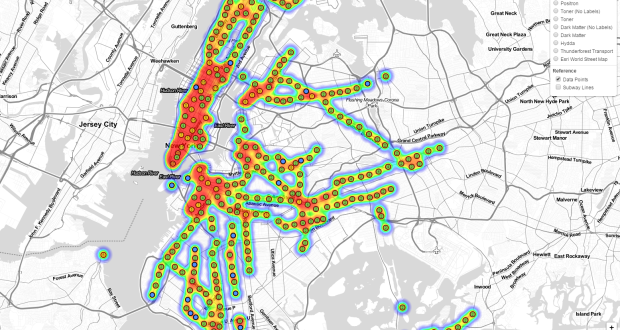Numerous commuters take the subway to get to work and reach other destinations. In New York City alone, over 4.3 million people use this mode of transportation on a daily basis. Given all of this traffic, it shouldn’t come as a surprise that subway lines host all sorts of germs. The exact number of organisms, however, might come as a bit of a shock.
A Very Crowded Ride
Researchers from Weill Cornell Medical College recently found 637 known microbe species inside of New York City’s subway system. In addition, nearly the same number of unknown bacterial, fungal, viral and animal organisms were also uncovered. Living bacteria was detected at every subway site examined by the study.
The project’s research team was comprised largely of medical students, graduate students and student volunteers. This group spent 17 months collecting DNA samples from each of New York City’s 466 open subway stations. At these numerous locations, the team collected genetic material from turnstiles, stairway railings, benches, trash cans and kiosks with the aid of nylon swabs.
Seeking to paint as detailed a picture as possible, the researchers took additional samples inside the subway trains themselves, directing their focus towards seats, handrails, doors and poles. In total, more than 4,200 samples were taken from New York’s subway lines, of which roughly 1450 underwent DNA sequencing.
Bubonic Plague on Subway Lines?
Having sequenced much of their material, the study authors then set about identifying their sizable collection of microbes, comparing their makeup to known types of bacteria, viruses and other organisms. Bacteria accounted for nearly half (46.9%) of the life forms discovered, whereas 48.3% of sample DNA fell into the “unknown organism” category. Conversely, viruses claimed a much smaller slice of the genetic pie (a mere .032%).
On the surface, some of the germs found in the samples would seem to be cause for alarm. For example, the study turned up bacterial DNA associated with urinary tract infections, staph infections, meningitis and sepsis. Microbes connected to food poisoning, respiratory infections and heart valve disease were likewise determined to be lurking in the city’s subways. The highlights didn’t stop there; the bacterium responsible for anthrax (bacillus anthracis) was unearthed in two samples, whereas three samples contained traces of Bubonic plague. Bacteria linked to any sort of disease was observed in nearly one in eight samples (12%). Many of the germs found in the samples were noticeably resilient, with 27% exhibiting resistance to antibiotics.
So do these findings mean that the America’s subways are filled with infectious bio hazards? Not quite; for one thing, none of these notorious organisms displayed any signs of life. Moreover, there is also no evidence that anyone riding New York’s subways has been sickened by such microbes. Instead, the germs residing in this subway system likely have no discernible impact on the body, and some might even leave a positive impact.
In a Weill Cornell press release, senior author Dr. Christopher E. Mason stated the researchers’ data indicated “that most bacteria in these densely populated, highly trafficked transit areas are neutral to human health, and much of it is commonly found on the skin or in the gastrointestinal tract. These bacteria may even be helpful, since they can out-compete any dangerous bacteria.” Mason further noted that the samples’ harmful germs were not prevalent enough to infect passengers.
Other Findings
The Weill Cornell research team didn’t just find pathogen DNA in their samples; their efforts also offered a look at the dietary preferences of subway riders. Microbes from mozzarella cheese, pizza, sausage, cucumbers and even sauerkraut appeared in the samples. Organisms associated with chickpeas, often used to make foods like hummus and falafel, were also identified.
Human DNA was likewise left behind on subway surfaces. When examined, this genetic information largely echoed demographic data from various regions of the city. Both Hispanic and Asian genes, for instance, wound up on samples from a Hispanic area near Manhattan’s Chinatown. Additionally, study researchers collected African and Hispanic genes from a portion of North Harlem.
Using their samples, the authors created a “PathoMap,” a map of the microbes found in New York’s subway system. This map details the various organisms identified at specific stops throughout the city. The Weill Cornell team published their findings online in the journal Cell Systems.
 Natural Knowledge 24/7 Educate yourself with nutrition, health and fitness knowledge.
Natural Knowledge 24/7 Educate yourself with nutrition, health and fitness knowledge.






